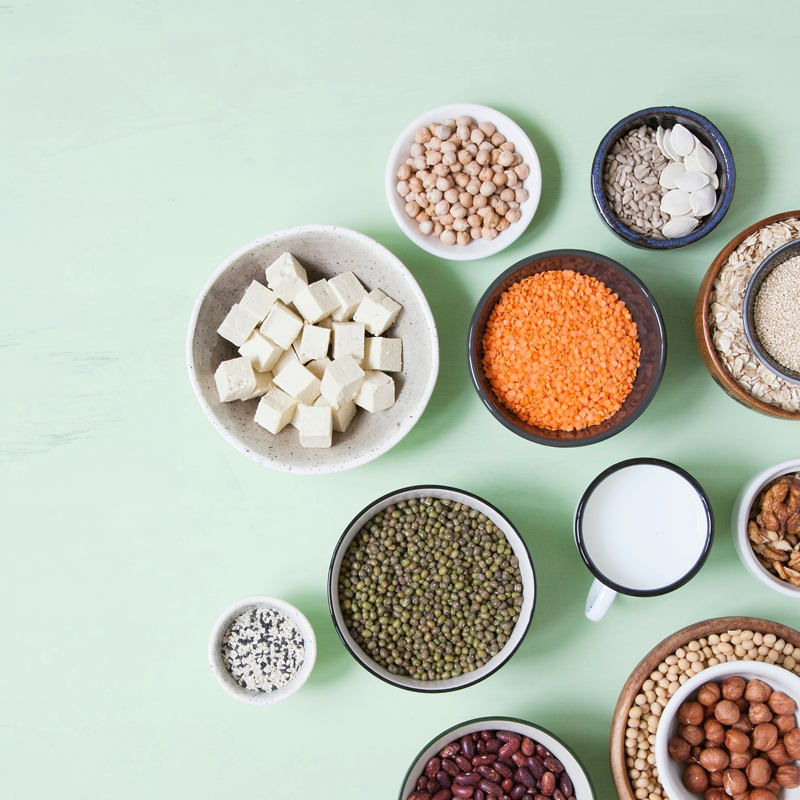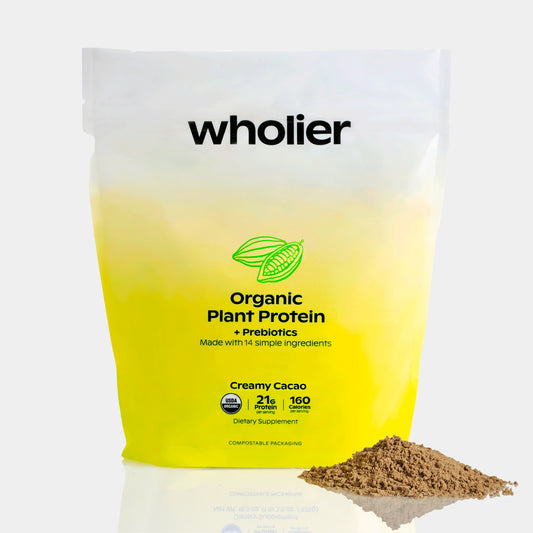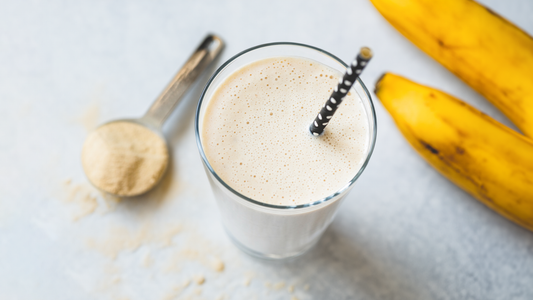
The Power of Plants: Non-Meat Protein Sources
Learn about the benefits and comparison of non-meat protein sources with our comprehensive guide to the top plant-based options.
Protein is an essential macronutrient that plays a crucial role in building and repairing tissues, producing hormones and enzymes, and maintaining healthy bones, muscles, and skin. While meat and animal products are commonly associated with protein, they're not the only sources. In fact, plant-based foods can also provide all the protein and essential amino acids needed for optimal health. This guide will explore non-meat sources of protein, their benefits, and how they compare to meat sources of protein.
Why is Protein Important, and What is a Complete Amino Acid Profile?
Protein is composed of amino acids, which are the building blocks of the body. There are 20 amino acids, nine of which are essential, meaning the body cannot produce them and must be obtained through the diet. A complete amino acid profile refers to a food that contains all nine essential amino acids in the proper proportions for the body's needs.
Protein plays a crucial role in various physiological processes, including:
- Building and repairing tissues
- Producing hormones and enzymes
- Maintaining healthy bones, muscles, and skin
- Supporting immune function
- Transporting nutrients throughout the body
It's essential to consume adequate protein to support these functions and prevent deficiency symptoms, such as muscle wasting, fatigue, and immune system dysfunction.
How Do Non-Meat Sources of Protein Compare to Meat Sources of Protein?
Meat is commonly associated with protein due to its high protein content, but plant-based foods can also provide all the protein and essential amino acids needed for optimal health. However, the protein content and amino acid profile may differ slightly between meat and non-meat sources of protein.
Meat is considered a complete protein source as it contains all nine essential amino acids in the proper proportions for the body's needs. However, it's also high in saturated fat, which has been linked to various health conditions, such as heart disease and certain cancers (1).
On the other hand, non-meat sources of protein may lack one or two essential amino acids, but consuming a variety of plant-based foods can easily provide all the essential amino acids needed for optimal health (2). Additionally, plant-based sources of protein are often lower in fat and cholesterol and higher in fiber and micronutrients, making them an excellent addition to a healthy diet.
Non-Meat Sources of Protein: A Comprehensive List
Contrary to popular belief, there's no shortage of protein in plant-based foods, and incorporating a variety of non-meat sources of protein into your diet can provide all the essential amino acids needed for optimal health. Here's a comprehensive list of non-meat sources of protein to help you meet your daily protein needs.
Legumes
Legumes are an excellent source of plant-based protein, with a half-cup of cooked beans containing about 7-10 grams of protein. Some examples include:
- Lentils (9 grams per half-cup) (3)
- Chickpeas (7 grams per half-cup) (4)
- Black beans (8 grams per half-cup) (5)
- Kidney beans (8 grams per half-cup) (6)
- Peas (4 grams per half-cup) (7)
Nuts and Seeds
Nuts and seeds are a great source of plant-based protein, healthy fats, and other essential nutrients. Some examples include:
- Almonds (6 grams per ounce) (8)
- Chia seeds (4 grams per tablespoon) (9)
- Flaxseeds (3 grams per tablespoon) (10)
- Pumpkin seeds (5 grams per ounce) (11)
- Sunflower seeds (6 grams per ounce) (12)
Grains
Whole grains are a healthy source of complex carbohydrates, fiber, and protein. Some examples include:
- Quinoa (8 grams per cup cooked) (13)
- Brown rice (5 grams per cup cooked) (14)
- Oats (5 grams per half-cup cooked) (15)
- Barley (4 grams per half-cup)
Vegetables
While vegetables may not be the first thing that comes to mind when thinking of protein sources, many vegetables contain a surprising amount of protein. Some examples include:
- Broccoli (3 grams per cup) (16)
- Spinach (5 grams per cup) (17)
- Brussels sprouts (3 grams per half-cup) (18)
- Artichokes (4 grams per medium-sized artichoke) (19)
Soy Products
Soy products are a popular source of plant-based protein, and they're often considered a complete protein source due to their amino acid profile. Some examples include:
- Tofu (10 grams per half-cup) (20)
- Tempeh (15 grams per half-cup) (21)
- Edamame (8 grams per half-cup) (22)
- Soy milk (8 grams per cup) (23)
Getting enough protein is essential for optimal health, and non-meat sources of protein can provide all the protein and essential amino acids needed. Incorporating a variety of protein-rich plant-based foods into your diet can offer numerous health benefits, including reducing the risk of chronic diseases and promoting overall well-being.
It's worth noting that the protein content and quality of plant-based foods can vary, so it's important to consume a variety of these foods to ensure that you're getting all the essential amino acids and nutrients needed for optimal health.
Overall, a plant-based diet can be a healthy and sustainable way of getting all the nutrients and protein your body needs to thrive. By incorporating non-meat sources of protein into your diet, you can ensure that you're meeting your daily protein needs.
Sources:
(1) Micha, R., Michas, G., & Mozaffarian, D. (2012). Unprocessed red and processed meats and risk of coronary artery disease and type 2 diabetes-an updated review of the evidence. Current atherosclerosis reports, 14(6), 515-524.
(2) Young, V. R., & Pellett, P. L. (1994). Plant proteins in relation to human protein and amino acid nutrition. The American journal of clinical nutrition, 59(5), 1203S-1212S.
(3) Lentils, mature seeds, cooked, boiled, without salt. (n.d.). Retrieved August 23, 2021, from https://fdc.nal.usda.gov/fdc-app.html#/food-details/170141/nutrients
(4) Chickpeas (garbanzo beans, bengal gram), mature seeds, cooked, boiled, without salt. (n.d.). Retrieved August 23, 2021, from https://fdc.nal.usda.gov/fdc-app.html#/food-details/170215/nutrients
(5) Black beans, mature seeds, cooked, boiled, without salt. (n.d.). Retrieved August 23, 2021, from https://fdc.nal.usda.gov/fdc-app.html#/food-details/170000/nutrients
(6) Kidney beans, mature seeds, cooked, boiled, without salt. (n.d.). Retrieved August 23, 2021, from https://fdc.nal.usda.gov/fdc-app.html#/food-details/169998/nutrients
(7) Peas, green, cooked, boiled, drained, without salt. (n.d.). Retrieved August 23, 2021, from https://fdc.nal.usda.gov/fdc-app.html#/food-details/170299/nutrients
(8) Nuts, almonds. (n.d.). Retrieved August 23, 2021, from https://fdc.nal.usda.gov /fdc-app.html#/food-details/170379/nutrients
(9) Seeds, chia seeds, dried. (n.d.). Retrieved August 23, 2021, from https://fdc.nal.usda.gov/fdc-app.html#/food-details/174962/nutrients
(10) Seeds, flaxseed. (n.d.). Retrieved August 23, 2021, from https://fdc.nal.usda.gov/fdc-app.html#/food-details/170413/nutrients
(11) Seeds, pumpkin and squash seed kernels, roasted, without salt. (n.d.). Retrieved August 23, 2021, from https://fdc.nal.usda.gov/fdc-app.html#/food-details/173753/nutrients
(12) Seeds, sunflower seed kernels, dried. (n.d.). Retrieved August 23, 2021, from https://fdc.nal.usda.gov/fdc-app.html#/food-details/169719/nutrients
(13) Quinoa, cooked. (n.d.). Retrieved August 23, 2021, from https://fdc.nal.usda.gov/fdc-app.html#/food-details/170299/nutrients
(14) Rice, brown, medium-grain, cooked. (n.d.). Retrieved August 23, 2021, from https://fdc.nal.usda.gov/fdc-app.html#/food-details/170524/nutrients
(15) Oats. (n.d.). Retrieved August 23, 2021, from https://fdc.nal.usda.gov/fdc-app.html#/food-details/170419/nutrients
(16) Broccoli, cooked, boiled, drained, without salt. (n.d.). Retrieved August 23, 2021, from https://fdc.nal.usda.gov/fdc-app.html#/food-details/170393/nutrients
(17) Spinach, cooked, boiled, drained, without salt. (n.d.). Retrieved August 23, 2021, from https://fdc.nal.usda.gov/fdc-app.html#/food-details/170409/nutrients
(18) Brussels sprouts, cooked, boiled, drained, without salt. (n.d.). Retrieved August 23, 2021, from https://fdc.nal.usda.gov/fdc-app.html#/food-details/170406/nutrients
(19) Artichokes, (globe or french), cooked, boiled, drained, without salt. (n.d.). Retrieved August 23, 2021, from https://fdc.nal.usda.gov/fdc-app.html#/food-details/171288/nutrients
(20) Tofu, salted and fermented (fuyu). (n.d.). Retrieved August 23, 2021, from https://fdc.nal.usda.gov/fdc-app.html#/food-details/171688/nutrients
(21) Soybeans, tempeh, cooked. (n.d.). Retrieved August 23, 2021, from https://fdc.nal.usda.gov/fdc-app.html#/food-details/175421/nutrients
(22) Soybeans, green, cooked, boiled, drained, without salt. (n.d.). Retrieved August 23, 2021, from https://fdc.nal.usda.gov/fdc-app.html#/food-details/170239/nutrients
(23) Soymilk (all flavors), unsweetened, with added calcium, vitamins A and D. (n.d.). Retrieved August 23, 2021, from https://fdc.nal.usda.gov/fdc-app.html#/food-details/170685/nutrients





